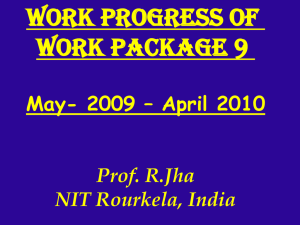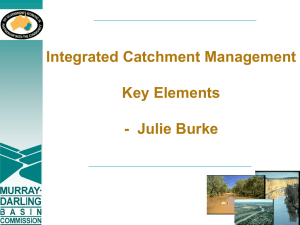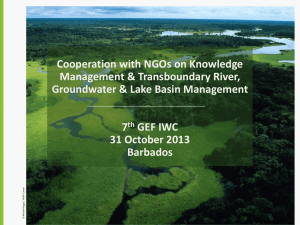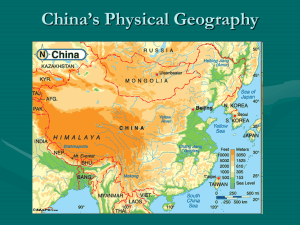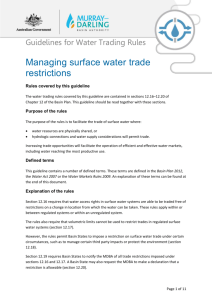Romania
advertisement
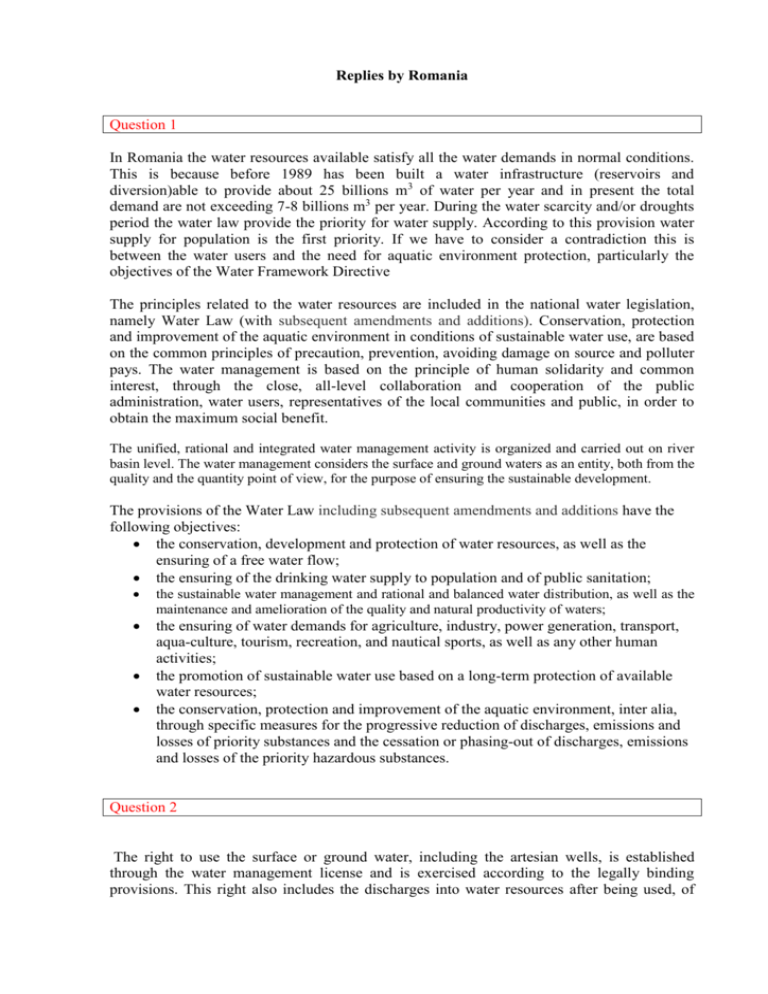
Replies by Romania Question 1 In Romania the water resources available satisfy all the water demands in normal conditions. This is because before 1989 has been built a water infrastructure (reservoirs and diversion)able to provide about 25 billions m3 of water per year and in present the total demand are not exceeding 7-8 billions m3 per year. During the water scarcity and/or droughts period the water law provide the priority for water supply. According to this provision water supply for population is the first priority. If we have to consider a contradiction this is between the water users and the need for aquatic environment protection, particularly the objectives of the Water Framework Directive The principles related to the water resources are included in the national water legislation, namely Water Law (with subsequent amendments and additions). Conservation, protection and improvement of the aquatic environment in conditions of sustainable water use, are based on the common principles of precaution, prevention, avoiding damage on source and polluter pays. The water management is based on the principle of human solidarity and common interest, through the close, all-level collaboration and cooperation of the public administration, water users, representatives of the local communities and public, in order to obtain the maximum social benefit. The unified, rational and integrated water management activity is organized and carried out on river basin level. The water management considers the surface and ground waters as an entity, both from the quality and the quantity point of view, for the purpose of ensuring the sustainable development. The provisions of the Water Law including subsequent amendments and additions have the following objectives: the conservation, development and protection of water resources, as well as the ensuring of a free water flow; the ensuring of the drinking water supply to population and of public sanitation; the sustainable water management and rational and balanced water distribution, as well as the maintenance and amelioration of the quality and natural productivity of waters; the ensuring of water demands for agriculture, industry, power generation, transport, aqua-culture, tourism, recreation, and nautical sports, as well as any other human activities; the promotion of sustainable water use based on a long-term protection of available water resources; the conservation, protection and improvement of the aquatic environment, inter alia, through specific measures for the progressive reduction of discharges, emissions and losses of priority substances and the cessation or phasing-out of discharges, emissions and losses of the priority hazardous substances. Question 2 The right to use the surface or ground water, including the artesian wells, is established through the water management license and is exercised according to the legally binding provisions. This right also includes the discharges into water resources after being used, of wastewater, surface and subsurface drainage water, rain run-off water, mine and deposit water. The surface or ground water may be used with no restraint, by complying with the sanitary and water quality protection norms requested for drinking, animal watering, sprinkling, washing, bathing and other domestic uses if for such activities no installations or low capacity installations up to 0.2 l/s, are used, for exclusive meeting of the own domestic needs. Meeting of the population water needs shall take priority over the use of water for other purposes. Also, water supply for animals, restoration of the intangible water reserves after fire events, as well as water flows required for maintaining of the biological equilibrium of the aquatic habitat, shall take priority over other water uses. Constraints of the drinking water use of the population for the benefit of other activities are forbidden. The drinking water distributed in organized manner to the populated areas, may be used for other purposes too, only if the water needs for population, animals, and other activities requesting water of such quality, are fully met. The drinking water supply for other purposes shall be restricted or eliminated only when new drinking water supply requirements for the population occur. The qualitatively appropriate groundwater shall be primarily designated for the population and animals water supply, as well as for ensuring the population sanitation and health. These waters may be used for other purposes only on the basis of the water management license. Water flow transfer between river basins shall be carried out only if provided that, the water needs for the basin in which water is intended to transfer are insufficient both for population and for maintenance of the biological equilibrium of the aquatic ecosystem, and the state of the river basin from which water is transferred is not disturbed. According to the provisions of Water Law including subsequent amendments and additions, the central public administration responsible for water field and the National Administration “Apele Romane”. This institution is entitled to take measures of temporary restriction or suspension of water use, in order to cope with a hazard, or consequences of accidents, drought, floods, or water shortage risks due to the resource overuse. Following provisions of the Water Law are applied in case of water restrictions due to natural causes: if due to the drought or other natural calamities, the authorized water flows cannot be ensured to all authorized users, temporary restrictions of water resources use shall be applied. the restrictions are established through water restriction and use plans for water shortage periods, developed by the water directorates, after consultation of the authorized users, with the agreement of the National Administration “Apele Romane” and with the approval of the Basin Committee (see question on public participation). The water restriction and use plans for water shortage periods (namely restriction plan), will be brought to the public knowledge in due time. The methodology for the restriction plans preparation and approval and the public information procedure is approved through ministerial order of the central public authority responsible for water field and published within the Official Journal of Romania. This methodology will take into account also social and economic importance of the authorized users. The measures established within the restriction plans shall be mandatory for all water users. Restriction measures shall be assimilated to the force majeure situations. Throughout the restriction plan application, the water management license provisions shall be subordinated to them. "Study on evolution scenarios of water requirements for water users for grounding actions and measures necessary to achieve the objectives of sustainable management of river basin water resources" (2008, National Institute of Hydrology and Water Management) presented scenarios at the level of each hydrographic basin for 2010 – 2020 period. The results of this study include, inter alia: Identifying trends in the evolution of the water requirements for water users. The following water uses have been taken into account: uses and specific uses: water for population, industrial water, irrigation, livestock and aquaculture / fisheries. Identifying factors that depend on water requirements of users. These factors are: nature of water use (public water supply, industrial water, irrigation, livestock, energy production etc.); rate/price of water; existence of alternative sources; availability of water at source; quality of service; population and its households; current state of water supply systems (water losses, etc.); employment rate of the population; Water balance: the main issue of the management of water resources is representing by the coverage of water requirements of users. Balance was performed both at country level and within each basin / catchment area. We did not encounter significant problems in implementing existing policies related to the water use. Question 3 The elaboration of the national water strategy and policy in water management field, the ensuring of the coordination and control of the application of the national and international regulations in this domain is carried out by the central public authority responsible for water field, respectively Ministry of Environment and Climate Changes. Water management in Romania is based on the following principles: water is a finite and vulnerable resources; water management is organized at the level of river basin; integrated management for quality and quantity; river basin solidarity; polluter pays and user pays; beneficiary pays. From the qualitative point of view the main objective of the water policy is the implementation of the Water Framework Directive. The main instrument for the implementation of this directive is the River Basin Management Plan. Within this Plan there is a program of measures targeted to fulfillment of the good water status. One of the main basic measures of this program is related to the improvement of the urban waste water treatment. Improvement of the urban waste water treatment is done according with the specific EU Directive and will lead to the improvement, extension or building collection and treatment infrastructure in all agglomerations with more than 2000 equivalent inhabitants. According with the commitments taken during the negotiations for European integration, this infrastructure should be in place at the end of 2018. The water resources management is based on the integration of all water categories; the integration of water uses at river basin level – solving of equation resource – water demand and the water resources protection require the analysis of uses at river basin level; aater resources management requires the involvement of all stakeholders - public and private - at all levels and when portivit. Decisions and actions in the field of integrated water resources must be taken by all those who may be affected accordingly the most appropriate level (subsidiarity principle); integration of upstream - downstream Upstream uses should recognize the rights of downstream uses in the use of water resources of good quality and in sufficient quantity. This requires dialogue to reconcile the needs of upstream and downstream uses; integration of water resources planning policies: water is one of the fundamental elements of life and at the same time a factor that makes social and economic development, often a limiting factor. Others documents of interest for the water resources management: The National Plan for Development 2007 – 2013, The National Plan for Rural Development 2007 – 2013”; Strategy for Energy 2007 – 2020”; Strategy for Tourism; Strategy for development of medium and small size towns 2005 – 2015; Regional Operational Programme 2007 – 2013. As it was previously mention, provision of the drinking water and sanitation (collection and treatment of the urban waste water) to the population is one of the main priority of the water management in Romania. Moreover these two activities are covered by two European Union directives which Romania committed to implement at a certain deadline. In order to support Romania in this very difficult task , the EU is providing (through different programs as SOP Environment, ROP, FEADR, etc) important financial resources for realization of the needed infrastructure . However, despite this support, the main contribution should come from the Romanian authorities. Question 4 The national legal frame for transparency, access to information and public participation consists from Law no. 544/2001 on free access to information of public interest and, in particular for water resources management: Water Law including subsequent amendments and additions (107/1996); Govermental Decison on the approval of Regulation for organization and functioning of Basin Committees (2012); Ministerial Order on the Procedure for public information access related to the water management field (2005); and Ministerial Order on the Procedure for water users, riparians and public consultation in the decision making process related to the water managenet field (2005). The water management is based on the principle of human solidarity and common interest, through the close, all-level collaboration and cooperation of the public administration, water users, representatives of the local communities and public, in order to obtain the maximum social benefit. Except for special cases like droughts, floods or others of the kind, the measures the central public authority responsible in water field has the right to take, for the implementation of the provisions of this law, concerning the protection of the surface and ground waters, as well as for the making sure the water supply, and which affect the interests of the water users, of the riparian residents, or of the public, shall be taken only after having consulted these persons. In order to achieve the consultation, the central public authority responsible in water field and the National Administration “Apele Romane” or its river basin water directorates; as appropriate, will publish a notice of the proposed measures in the local newspaper. The same notice is sent to the water users, the riparian residents, as well as to any other person that might be affected. The text of the proposed measures, as well as any supporting documentation, is made available for the public at the units. The written comments, observations or suggestions on the proposed measures are sent to the informant in no more than 45 days, from the date the notice was published. In case special, significant or controversial measures were proposed, the informant shall make arrangements for a public debate, 60 days after the notice was published. The central public authority responsible in water field, or the National Administration “Apele Romane”, as appropriate, will review all observations and proposals before making a final decision. A text of the final decision and its explanation shall be made available for the public. The procedure concerning the participation of the water users, riparian residents and the public in the consultation activity shall be established by the central public authority responsible in water field. At each water administration level of the National Administration “Apele Romane”, a Basin Committee is organized. The BC represents the interests of all people in the river basin and it is used as the main platform for stakeholders consultation for water issues, including Water Framework Directive. The BC has a consultative role. This Committee consists of max. 21 members, as follows: two representatives of the central public authority responsible for water and environmental protection field; a representative of the central public authority responsible for health field; two municipality mayors and one town or commune mayor; one representative elected by the non-governmental organizations having the headquarters within the relevant river basin; one prefect from the relevant river basin; presidents of county councils within the basin; three representatives of the water users within the relevant river basin; two representatives of the National Administration “Apele Romane”; one representative of the district Authority for Consumers Protection.. The Committee will, inter alia,: endorse, before the manifestation of water shortages, plans and water uses restriction in times with deficit of waters; ensure• public information on activities organized at least 30 days before the date; ensure consultation with water users, riparians and the public and encourage their active participation in decision-making in water management, according to Water Law no. 107/1996, as amended and supplemented; ensure debates and public hearings on all matters submitted for approval; ensure public access to debates and public hearings and their official documents; ensure public information, and to guarantee a period of time required to receive public comments, to arrange public hearings on all the aspects proposed for approval, and to ensure the public access to its documents; Committee operates through meetings (up to four meetings/year) and public debates. Moreover, according with the provsions of the Romanian water legislation (based on the specific EU Directives) water management authorities has obligations for public information and for ensuring the framework of public participation. This issue is particularly important for the development of the River Basin Management Plan according with the Water Framework Directive. As it was mentioned before this Plan includes a Program of measures with all the needed and proposed infrastructure, include those for drinking water and sanitation. Question 5 Yes.



